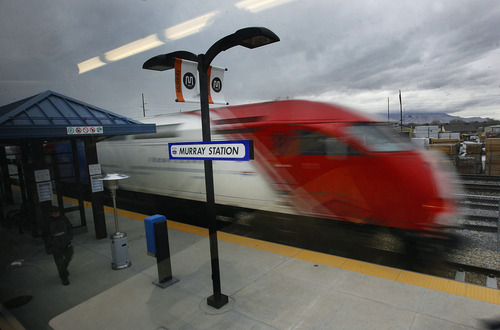This is an archived article that was published on sltrib.com in 2013, and information in the article may be outdated. It is provided only for personal research purposes and may not be reprinted.
The Utah Transit Authority has finished off its sexy showpieces.
TRAX light rail goes from Sandy to downtown Salt Lake City, from the University of Utah to Salt Lake International Airport (though not, sadly, directly from the U. to the airport). The FrontRunner commuter trains fly down the rails all the way from Provo to Ogden.
In the process, the agency has earned a reputation for bringing in its showy capital projects ahead of schedule and under budget.
But these efforts have come at a price. And we're not just talking billions in federal and local dollars.
The money, brains and political capital that have been spent to create a UTA of gleaming trains and self-congratulatory billboards have, for years now, been diverted from the many more, shall we say, pedestrian concerns of getting people from here to there around and across the Wasatch Front.
This was the main point correctly raised by a group of area mayors and city council members when, Tuesday, they took advantage of the UTA board's invitation to give the system's managers an earful.
The people the transit tsars heard from were, in many cases, city officials who begged for, then welcomed with much fan fair, the TRAX and FrontRunner extensions that connected their cities with one another. Now, though, they were wisely pressing for some back-to-basics thinking.
Like more buses, which better move people to the rail systems or to and from places the trains do not, and likely will not, go. Buses that run more frequently and on better planned routes, the mayors and councilmen said, will make the rail services more useful to more people and, at the same time, make it easier for people who aren't going where the trains go to get to work, to school, to the store.
Ogden Mayor Mike Caldwell went so far as too suggest that a planned new UTA streetcar to connect the FrontRunner station with Weber State University might just as easily be another bus route, much cheaper and quicker to set up.
The system already charges basic fares that are the highest in the nation, and any significant improvement in the bus part of the system will cost money that might have to come from increasing the small local sales tax that already funds 71 percent of the network's cost. Without more support from a larger cross-section of the population, neither funding source will be politically viable.
The UTA rail system is no Potemkin village. They really go places that many people want to go, in the comfort that many people are willing to pay for. At the same time, though, rail is also a service aimed largely at people who could afford to drive their own cars but who need to be lured into the public transit fold because they are influential enough to keep the system politically and economically viable.
That destination has been arrived at. Now, UTA should be attending to matters more mundane.



